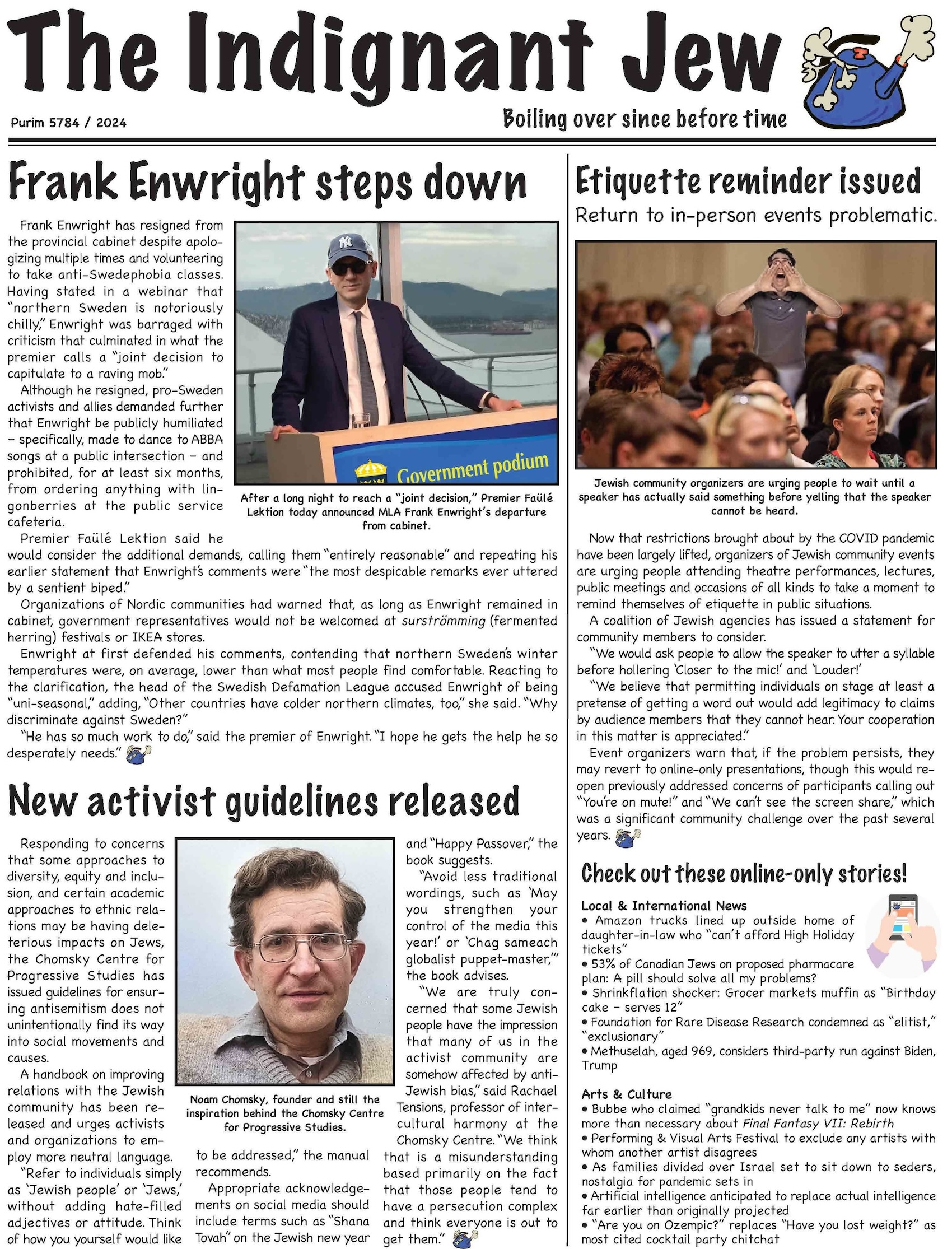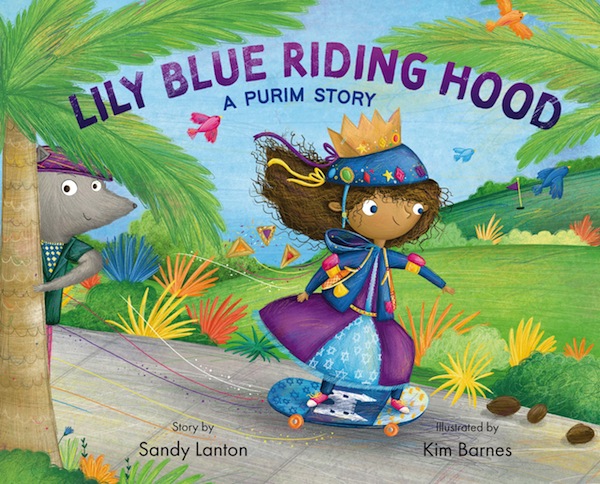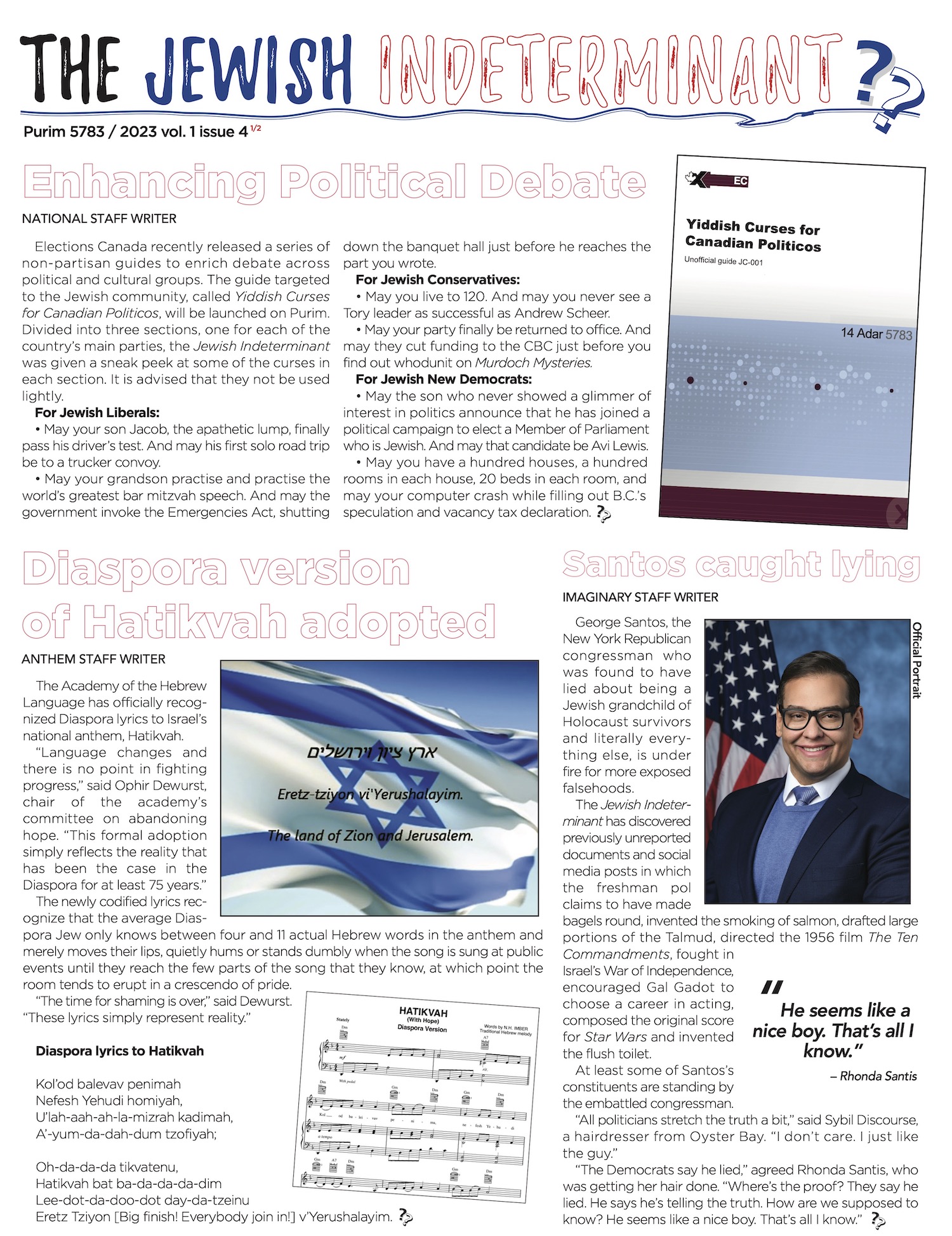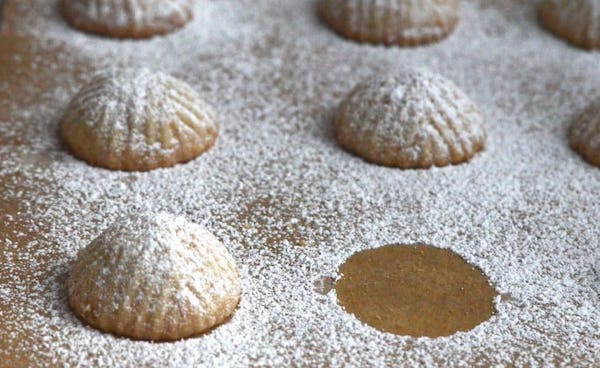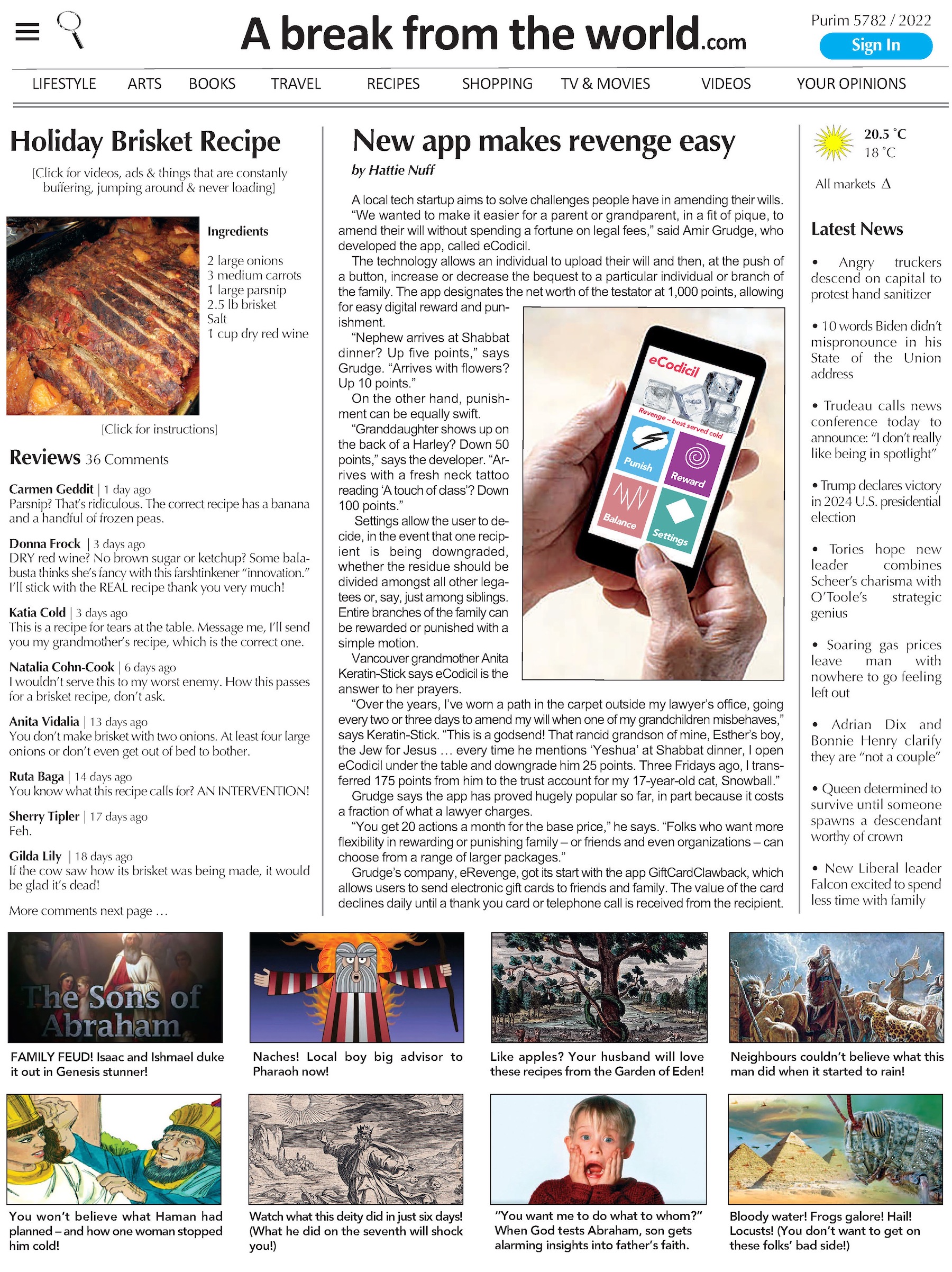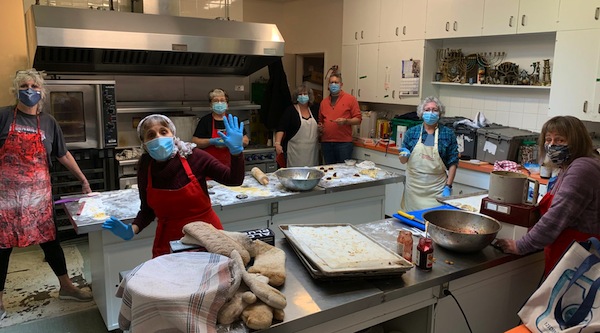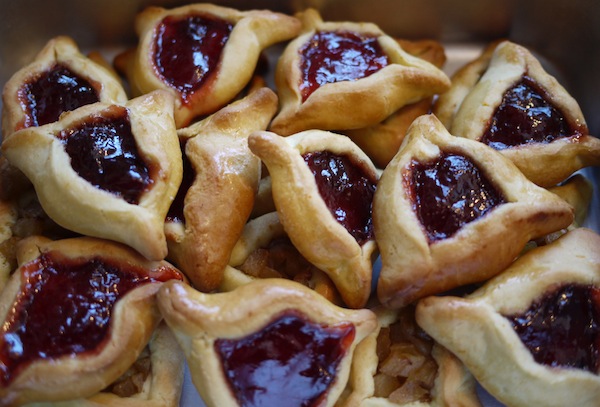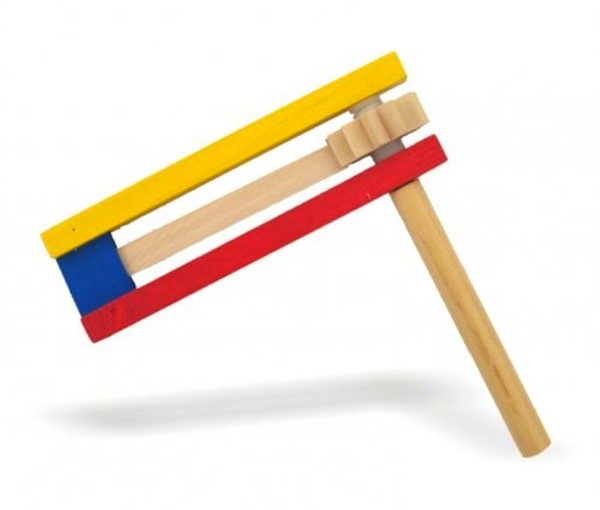Tag: Purim
Fresh new fairy tale
Making old, familiar stories new and fresh again. Writer Sandy Lanton and illustrator Kim Barnes do just this with their take on Red Riding Hood: Lily Blue Riding Hood, published by Seattle’s Intergalactic Afikoman.
Lily loves to skateboard and almost every page of Lily Blue Riding Hood is full of movement, as she swiftly rolls to everywhere she needs to be. On Purim, it’s to Granny’s house, with her blue hoodie pulled over her Queen Esther costume, its crown atop her helmet, her backpack full of hamantashen she’s just baked (leaving behind the messiest of kitchens). On the way, she passes Thaddeus T. Wolfe and chats long enough with him that the smell of the hamantashen gets him plotting how he can get Granny’s treats for himself.
Readers can make their own treats using the recipe for Lily’s Skateboarding Hamantashen, which are the regular triangle shape, but then attached to a long flat cookie, the “skateboard,” and either small round cookie or candy “wheels.” The recipe page also includes a paragraph on what Purim is and how it’s celebrated.
Lily Blue Riding Hood is a colourful and humour-filled modern-day Jewish fairy tale that will make both adult and child readers smile.
Happy Purim 5783 / 2023!
Baked treats for Purim
Maureen Abood’s verion of ma’amoul. (photo from maureenabood.com)
There are many different Purim foods around the world. In an article from several years ago on aish.com, Dr. Yvette Alt Miller gives recipes for a dozen lesser-known treats. Among them are kreplach, which she describes as a “hidden” food in that the filling is covered up by dough; therefore, it’s appropriate for Purim because of all the hidden aspects in the Purim story.
Other baked treats Miller suggests are French palmiers, to evoke the ears of Haman; Russian kulich, a long, sweet challah loaf, resembling ropes like those Haman wanted to use to hang Mordechai and on which he was hanged; Moroccan Purim bread, boyoja ungola di Purim, using hard-boiled eggs to represent Haman’s eyes; the Bulgarian pasta dish caveos di Aman (Haman’s hair); the Israeli orecchi di Aman (Haman’s twisted ears) and Persian nanbrangl (Haman’s fleas). For all the recipes, visit aish.com/purim_foods_around_the_world.
Here are three other recipes to try. Jews from Syria, Lebanon and Egypt make ma’amoul (which means filled) for Purim – the filling can be nuts (including, but not usually, almonds) or dried fruits, like dates or figs. I’ve also made poppy seed pound cake for the holiday, and my friend (cookbook author) Joan Nathan’s recipe for figs stuffed with walnuts.
MA’AMOUL
(makes 36 cookies)
filling:
1 cup finely chopped nuts (pistachio or walnuts)
1/4 cup sugar
1 tsp orange-blossom water
1 tsp water
dough:
3 cups white flour
1 cup unsalted butter or margarine, cut in pieces
2 tbsp water
1 tbsp orange-blossom water
confectioners’ sugar
- Preheat oven to 400°F.
- In a bowl, place flour. Cut in butter or margarine until mixture resembles coarse crumbs. Sprinkle orange-blossom water over dough. Stir and knead about three minutes.
- Form into 36 balls with a scant tablespoon for each ball. Hold each ball in your hand, make an indentation in the middle and work dough out to form a small cup about a quarter-inch thick.
- Combine nuts, sugar, orange blossom water and water for filling. Fill each ball with one teaspoon filling. Pinch dough, sealing in filling and molding the top to resemble a gumdrop. Using the tines of a fork, decorate the cookies.
- Place cookies one inch apart on ungreased cookie sheet. Bake 20 to 22 minutes until light brown around bottom edges and pointed tops.
- Before serving, cool and then sprinkle confectioners’ sugar on top.
POPPY SEED POUND CAKE
1/3 cup poppy seeds
1 cup milk
1 cup margarine
1 cup sugar
4 eggs, separated
1 tsp vanilla
1/2 tsp almond extract
2 1/2 cups flour
1 tsp baking soda
2 tsp baking powder
1/2 cup sugar
1 tbsp cinnamon
- Preheat oven to 350°F. Grease a tube pan.
- In a bowl, mix poppy seeds with milk and let sit five minutes.
- In a larger bowl, cream margarine, 3/4 cup sugar, egg yolks, vanilla and almond extract.
- In another bowl, combine flour, baking soda and baking powder. Add alternately to creamed mixture with poppy seeds and milk.
- In another bowl, beat egg whites then add 1/4 cup sugar. Carefully fold in to batter.
- Combine sugar and cinnamon in a small bowl.
- Pour half the batter into the greased tube pan, sprinkle with half the cinnamon sugar then pour in the rest of batter and top with the remainder of the cinnamon sugar. Bake for 55 to 60 minutes.
FIGS STUFFED WITH WALNUTS
(This recipe comes from Joan Nathan’s Jewish Holiday Kitchen. It makes 6 servings.)
12 dried figs
12 walnut halves
grated coconut (optional)
Open the centre of each fig and place a walnut half inside, then roll the stuffed fig in grated coconut, if using. Place on a dish with other fruit and serve.
Sybil Kaplan is a journalist, author, editor/compiler of nine kosher cookbooks (working on a 10th) and a food writer living in Jerusalem. She leads English-language Shuk Walks in Machane Yehuda and writes restaurant features for janglo.net.
Happy Purim 5782 / 2022!
Spreading joy on Purim
In the kitchen, left to right, are Stacey Kettleman, Leah Reghatti, Francie Steen, Deborah and David Freedman, Shelley Ail and Linda Rothberg. (photo from Beth Tikvah)
This Purim, Beth Tikvah Congregation packaged more than 240 holiday bundles, delivering one to every member household – spreading not only joy, but raising funds for the synagogue’s preschool and Hebrew school.
“As we enter the month of Adar, our tradition teaches, we must increase joy,” explained Rabbi Susie Tendler, the congregation’s spiritual leader. “The talmudic statement (Ta’anit 29a) is not specific about whose joy we are increasing, rather that it is incumbent upon us to spread joy and cheer, brightening these dark days. Communities around the globe have certainly been wrestling with how to deepen connections and spread joy this past year. Beth Tikvah decided to take the wisdom of our tradition and do so through festive and colourful mishloach manot, Purim packages, that went to every member family living in British Columbia.”
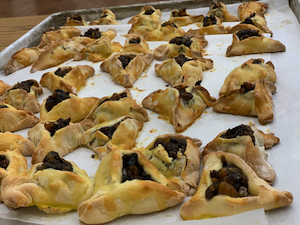
The effort was multigenerational. There were the volunteers in the kitchen, who made more than 1,000 hamantashen. B’nai mitzvah families and the congregation’s youth groups (USY and Kadima) helped assemble the packages. There were the volunteers who counted, sorted and put the finishing touches on the packages, and those who picked up and delivered the packages all over Richmond and Vancouver. And, of course, the whole endeavour would not have been possible without those who funded it.
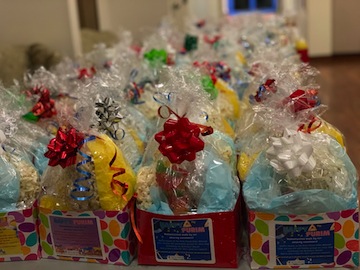
In addition to all the congregants who ordered the mishloach manot and volunteered in various ways, Isha L’Isha was a sponsor of the initiative, Leanne Hazon supported the program “relentlessly during all hours of the day,” Alon Sabi designed the ordering system, and BT program manager Yvette Sabi created the boxes.
“For me,” said Tendler, “particularly during COVID, the opportunity to hang a bundle from someone’s door, ring the bell, and then step back three metres or so, and wish someone a happy holiday personally was splendid. However, the joy did not stop there. We received an outpouring of communications from people testifying to the joy and surprise felt from these packages which, in turn, deepened the joy felt by all of the volunteers. It is true, sometimes the little things bring the biggest smiles, and one smile significantly sparks another smile.
JI makes for regal crown
Aaron Dewitt put the Feb. 12 issue of the Jewish Independent to good use on Purim – after reading it from cover to cover, we trust. (photo by Rahel Halabe)
Purim sameach!
Symbolic treats for Purim
While hamantashen are one of the most known Ashkenazi treats, many other foods are associated with Purim. (photo by Rebecca Siegel)
In the Book of Esther, all we are told is that letters were sent to the Jews in the provinces, telling them to have days of feasting and gladness. Fourth-century scholar Rava interpreted this to mean a seudat Purim, a meal in the late afternoon, to differentiate Purim from other days.
There are no rituals attached to the seudah, and no special Kiddush is said, though some people make up a Purim Kiddush, which is nonsense or a parody on something in the Torah.
Kalonymos ben Kalonymos, a French writer, philosopher and translator who lived in the 13th and 14th centuries, wrote a parody of a talmudic tractate, called Masekhet Purim, citing 30 different dishes to eat on Purim. He included chestnuts, duck, venison, goose and pigeon.
One custom, particularly of Jews of Middle Eastern backgrounds but also of some Ashkenazim, is to serve dishes with chickpeas on Purim. Why is this done? They say, in order to remind us that, to keep kosher, Esther lived on vegetables, notably beans and peas.
Another custom, according to the late Gil Marks in the Encyclopedia of Jewish Food, is to eat turkey, because Europeans had thought the bird came from India and the Book of Esther says Ahasuerus ruled from India to Kush. The Hebrew word for India, the country, and turkey, the animal, is hodu. Another idea is that the turkey bird is very foolish, and so was Ahasuerus.
Some people also serve kreplach, the triangular-shaped, meat-filled, savoury pastry on Purim. They do so because the meat inside is prepared by chopping, which is a form of “beating,” akin to the stamping of feet on the floor to drown out Haman’s name.
In the 17th century, European Jews made a dish called megillah kroyt, consisting of sauerkraut, raisins and honey. A stringy dish, it symbolized the rope used to hang Haman.
In her book Quiches, Kugels and Couscous, on Jewish cooking in France, Joan Nathan writes that Jews of Alsace made Alsatian Chouroute, sauerkraut with sausage and corned beef, because the sausage hangs in butcher shops and reminds them of Haman. The Alsatians also call the corned beef “the Haman.”
At the actual seudah, Marks says that Ashkenazim often serve koyletsh, or keylitsh in Russian – a long, braided challah symbolizing the rope on which Haman was hanged. Other Ashkenazi dishes include kreplach in chicken soup, knishes, pirogen (filled, boiled, pasta dumplings), stuffed roast chicken or veal breast, stuffed cabbage, and tzimmes.
Some Sephardim serve breads or foulares (pastries filled with long-cooked eggs), sambusak (meat turnovers), stewed chicken, and rice with chickpeas or nuts.
According to Encyclopedia of Jewish Food, because the name of G-d is not mentioned in the Book of Esther, “the sense of the mysterious and hidden extends even to the food.” In other words, we cannot see the fillings inside and that alludes to “the many intrigues, secrets and surprises unfolding in the Purim story.”
The sweets served on Purim symbolize a good “lot” and a sweet future. In fact, Muslims refer to Purim as Id-al-Sukkar, the Sugar Holiday.
The most important aspect of many Purim pastries is their shape. Most Ashkenazi Jews only know of hamantashen, the name for which comes from the German mohn (meaning poppy seeds) and taschen (referring to pockets). Some say the pockets refer to Haman, who stuffed his pockets with bribe money.
The original name was mohntaschen, and the tradition of eating them may date back as far as the 12th century. Shmil Holland, the Israeli historian, caterer and cook, says, when Jews fled Germany for Eastern Europe in the late Middle Ages, they took the poppy seed pastry with them and added the Yiddish prefix “ha,” thus making it hamantash. The Midrash, however, says, while reflecting on his plan to get rid of the Jews, Haman realized the three Patriarchs would intercede. Thus, the pastry is triangular in shape.
Sybil Kaplan is a journalist, lecturer, book reviewer and food writer in Jerusalem. She created and leads the weekly English-language Shuk Walks in Machane Yehuda, she has compiled and edited nine kosher cookbooks, and is the author of Witness to History: Ten Years as a Woman Journalist in Israel.
Why groggers on Purim?
(photo from ajudaica.com)
One of the most popular customs for Purim is to drown out the name of the villain, Haman, with a noisemaker. In Hebrew, it is called a ra’ashan; in Yiddish, it is a grogger, which comes from the Polish word for rattle.
The origin of this custom comes from the Book of Exodus 17:4: “For I will utterly blot out the remembrance of Amalek from under the Heavens.” Haman’s ancestors were Amalekites.
While the custom of using a noisemaker during the reading of the Megillah is more recent among Sephardi Jews, some form of grogger has been used primarily among Ashkenazi Jews since the Middle Ages.
There are records that children in ninth-century France and Germany used groggers on Purim. They took flat stones or wooden paddles on which Haman’s name was inscribed and beat them together when Haman’s name was mentioned in the reading of Megillat Ester. It was also popular to write Haman’s name on the soles of their shoes and then stamp their feet when his name was read, thus erasing his name.
Today, the traditional grogger looks like the Hebrew letter dalet, a horizontal piece made of wood or metal with a rotating cylinder or tongue attached to a vertical handle, which, when turned, makes noise.
One also finds groggers decorated with illustrations from the Book of Esther, plastic groggers with clapping hands, and designs in wood and metal. Schoolchildren often make their own containers of paper or metal and then fill them with beans, so that, when they are shaken, they make noise.
Whatever grogger you use for Purim, just make sure you do it loud and often, for, in each generation, a Haman has arisen to live among us!
Sybil Kaplan is a journalist, lecturer, book reviewer and food writer in Jerusalem. She created and leads the weekly English-language Shuk Walks in Machane Yehuda, she has compiled and edited nine kosher cookbooks, and is the author of Witness to History: Ten Years as a Woman Journalist in Israel.

